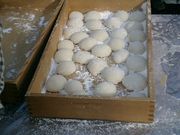Mochi

Rice Cake Kirimochi (切り餅) or Kakumochi (角餅)

Rice Cake Marumochi (丸餅)

Pounding mochi in an usu
Making mochi with a modern piece of equipment
|
Mochi (Japanese: 餅) is a Japanese rice cake made of glutinous rice pounded into paste and molded into shape. In Japan it is traditionally made in a ceremony called mochitsuki.[1] While also eaten year-round, mochi is a traditional food for the Japanese New Year and is commonly sold and eaten during that time. Mochi is also a prominent snack in Hawaii, Taiwan, Cambodia, and Thailand.
Contents |
Mochitsuki
Mochitsuki is the traditional mochi-pounding ceremony in Japan.
- Polished glutinous rice is soaked overnight and cooked.
- The cooked rice is pounded with wooden mallets (kine) in a traditional mortar (usu). Two people will alternate the work, one pounding and the other turning and wetting the mochi. They must keep a steady rhythm or they may accidentally injure one another with the heavy kine.
- The sticky mass is then formed into various shapes (usually a sphere or cube).
Though Mochitsuki is the traditional preparation method, mochi can also be cooked in the microwave.[2]
Popular uses for mochi
Confectionery
Many types of traditional wagashi and mochigashi (Japanese traditional sweets) are made with mochi. For example, daifuku is a soft round mochi stuffed with sweet filling, such as sweetened red bean paste (an) or white bean paste (shiro an). Ichigo daifuku is a version containing a whole strawberry inside.
Kusa mochi is a green variety of mochi flavored with yomogi (mugwort). When daifuku is made with kusa mochi, it is called yomogi daifuku.
Ice cream
Small balls of ice cream are wrapped inside a mochi covering to make mochi ice cream. In Japan this is manufactured by the conglomerate Lotte under the name Yukimi Daifuku, "snow-viewing daifuku". In the United States the grocery chains Trader Joe's, H Mart, and Mollie Stone's sell mochi ice cream in flavors of chocolate, mango, green tea, coffee, vanilla, and strawberry. Mikawaya, a Japanese-owned company operating in Los Angeles, manufactures the variety that is sold by Trader Joe's and Mollie Stone's. The New Central Market in Anchorage Alaska provides a variety of mochi and mochi ice cream products throughout Alaska. The Pinkberry, Big Spoon Yogurt and Red Mango frozen yogurt chains also offer mochi as standard topping on their desserts (with Red Mango offering it on their secret menu), available upon request from customers.
Soup
- Oshiruko or ozenzai is a sweet azuki bean soup with pieces of mochi. In winter, Japanese people often eat it to warm themselves.
- Chikara udon (meaning "power udon") is a dish consisting of udon noodles in soup topped with toasted mochi.
- Zōni soup. See New Year specialties below.
New Year specialties
- Kagami mochi is a New Year decoration, which is traditionally broken and eaten in a ritual called Kagami biraki (mirror opening).
- Zōni soup is a soup containing rice cakes. Zoni is also eaten on New Year's Day. In addition to mochi, zoni contains vegetables like honeywort, carrot, and red and white colored boiled kamaboko.
- Kinako mochi is a mochi dish that is traditionally made on New Year's Day for luck. This style of mochi preparation includes roasting the mochi over a fire or stove, and then dipping it into a mixture of soy sauce, water and sugar, before finally briefly coating it in kinako (soy flour).
Other
- Dango is a Japanese dumpling made from mochiko (rice flour).
- Warabimochi is not true mochi, but a jelly-like confection made from bracken starch and covered or dipped in kinako (sweet toasted soybean flour). It is popular in the summertime, and often sold from trucks, not unlike ice cream trucks in Western countries.
- More recently, "Moffles" (a waffle like machine used to cook mochi) has been introduced. [1]
- In the Philippines, palitaw is derived from Japanese mochi and sesame seeds are added to it.
See also
- Japanese New Year
- Kagami mochi
- Zōni
- Hishi mochi
- Kusa mochi
- Hanabiramochi
- Daifuku
- Senbei
- Wagashi
- Nian gao
- Tteok, Korean rice cakes
- Tangyuan (food)
References
- ↑ "Mochitsuki: A New Year’s Tradition". Japanese American National Museum. http://janmstore.com/mochitsuki.html.
- ↑ "Not-So-Stressful Microwave Mochi". The Fatty Reader. http://recipestoayoungpoet.blogspot.com/2010/05/not-so-stressful-microwave-mochi.html.
|
||||||||
|
||||||||||||||||||||||||